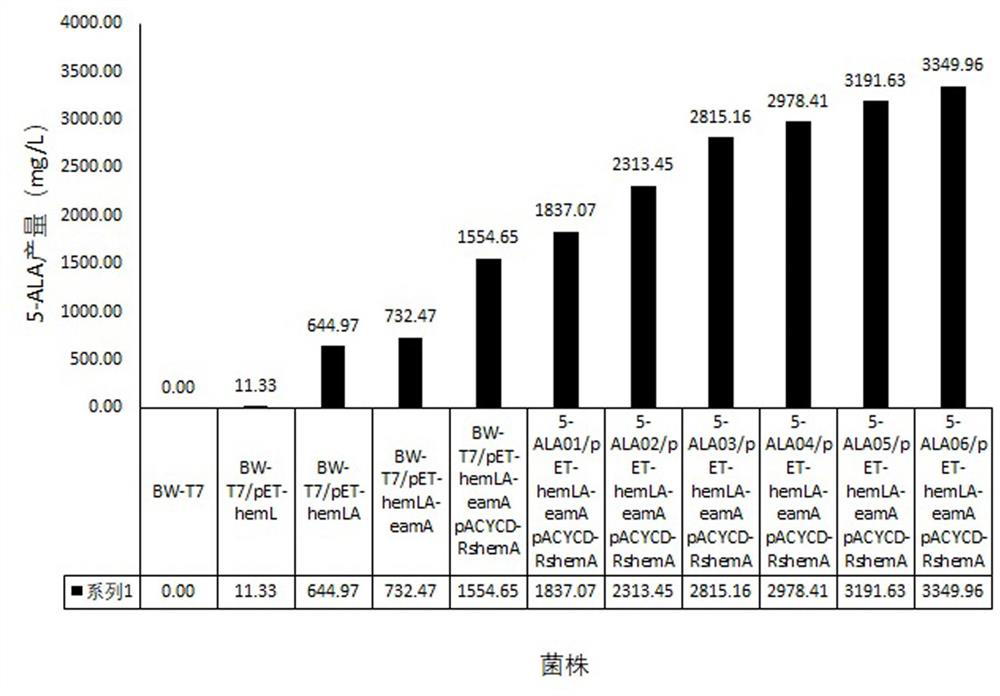A kind of high-yield 5-aminolevulinic acid recombinant Escherichia coli strain and its application
A technology of aminolevulinic acid and recombinant Escherichia coli, which is applied in the fields of metabolic engineering and microbial fermentation, can solve the problems of many reaction steps, many by-products, and low yield, and achieves the effect of optimizing the synthesis path and improving the utilization efficiency.
- Summary
- Abstract
- Description
- Claims
- Application Information
AI Technical Summary
Problems solved by technology
Method used
Image
Examples
Embodiment 1
[0105] Embodiment 1, construct the recombinant plasmid that expresses 5-ALA synthase
[0106] 1. Construction of recombinant plasmid pET28b-hML
[0107] (1) Extraction of E. coli genomic DNA and PCR amplification of heML gene.
[0108] The genomic DNA of Escherichia coli BW25113 or BL21(DE3) was extracted by bacterial genome extraction kit. Using the extracted genome as a template and heML-F and heML-R as primers, the gene fragment heML was amplified by high-fidelity Phanta max Super-Fidelity DNA polymerase PCR, and the target fragment was recovered by agarose gel electrophoresis.
[0109] (2) Construction of recombinant plasmid containing heML gene.
[0110] Using the pET28b empty plasmid as a template and V-pET28b-F and V-pET28b-R as primers, the vector fragment ET28b was amplified by high-fidelity Phantamax Super-Fidelity DNA polymerase, and the target fragment was recovered by agarose gel electrophoresis. ; The above-mentioned heML gene fragment was ligated with the ET2...
Embodiment 2
[0119] Embodiment two, construct the recombinant Escherichia coli strain that produces 5-ALA
[0120] 1. Construction of host bacteria
[0121] Using E. coli BW25113 as the starting strain, T7 was inserted into BW25113 using CRISPR / Cas9 technology (see the document "CRISPR / Cas9 mediated T7 RNA polymerase gene knock-in in E. coli BW25113makes T7 expression system work efficiently", Ye Changchuan). RNAP gene, construct BW25113-T7 strain.
[0122] Taking BW25113-T7 as the starting bacteria, a host bacteria including one or more of the following characters was constructed, and the genotypes of each host bacteria are shown in Table 1 below.
[0123] Table 1. Host strains and their genotypes
[0124] host bacteria genotype BW-T7 BW25113 int::(lacI::PlacUV5::T7 gene) ΔybhC 5-ALA01 BW-T7 △hemF 5-ALA02 BW-T7 △hemF △galR 5-ALA03 BW-T7 △hemF △galR::119-ppc 5-ALA04 BW-T7 △hemF △galR::119-ppc △poxB 5-ALA05 BW-T7 △hemF △galR::119-ppc △...
Embodiment 3
[0150] Embodiment 3. Utilize recombinant Escherichia coli engineering strain to produce 5-ALA
[0151] 1. Induction of 5-ALA-producing strains
[0152] The positive monoclonal bacteria stored at -80°C were streaked onto the corresponding resistant LB plates, and cultured upside down at 37°C for 12h. Single clones were picked, inoculated into liquid LB medium containing corresponding resistance, and cultured overnight at 37°C and 200 rpm with shaking. The production strains cultivated overnight were transferred to 30mL M9+yeast powder+gly medium at 2% inoculum, and cultivated to OD at 37°C and 200rpm. 600 =0.8, add IPTG with a final concentration of 0.1 mM for induction, and induce culture at 37°C and 200 rpm.
[0153] M9+yeast powder+gly medium formula: Na 2 HPO 4 ·12H 2 O 17.1g / L, KH 2 PO 4 3.0g / L, NaCl 0.5g / L, NH 4 Cl 1.0g / L, MgSO 4 2mM, CaCl 2 0.1mM, glucose 10g / L, yeast powder 2g / L, glycine 2g / L.
[0154] 2. Detection of 5-ALA
[0155] After adding the induce...
PUM
 Login to View More
Login to View More Abstract
Description
Claims
Application Information
 Login to View More
Login to View More - R&D
- Intellectual Property
- Life Sciences
- Materials
- Tech Scout
- Unparalleled Data Quality
- Higher Quality Content
- 60% Fewer Hallucinations
Browse by: Latest US Patents, China's latest patents, Technical Efficacy Thesaurus, Application Domain, Technology Topic, Popular Technical Reports.
© 2025 PatSnap. All rights reserved.Legal|Privacy policy|Modern Slavery Act Transparency Statement|Sitemap|About US| Contact US: help@patsnap.com

